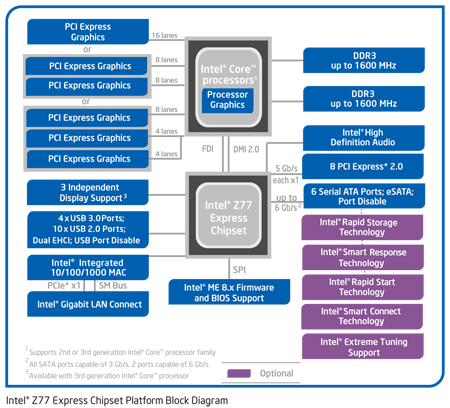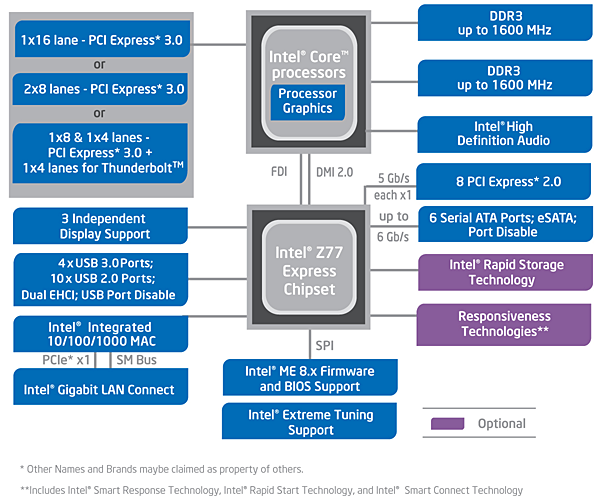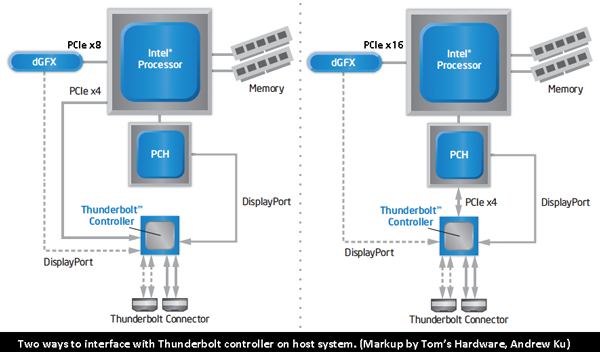Six $220-280 Z77 Express-Based Motherboards, Reviewed
Expanded graphics card support, enhanced on-board features that include Thunderbolt on some models, and more-robust voltage control are all good reasons to consider paying a little extra for a higher-end motherboard. Today we examine five top choices.
Panther Point's Thunderbolt Connection
Our Z77 launch article stated that the chipset's integrated USB 3.0 controller was nothing to get excited about, though it did free up a couple of the PCH’s eight PCIe 2.0 lanes. The one thing we didn’t discuss was the platform’s ability to support three graphics cards, because the block diagram shown below is actually an update from Intel.
Intel had good reason not to discuss x8/x4/x4 capability when Z77 Express launched, because it required a new CPU that would only be introduced weeks later. Instead we got a future-looking block diagram that merely hinted towards that upcoming CPU’s triple-device support.
In an almost fickle move, Intel followed its Ivy Bridge architecture launch by stepping back from its original Thunderbolt-naming block diagram to a more generic triple-card diagram. The company was thus able to make many of us forget that the PC market was getting the short end of the Thunderbolt stick until properly-equipped motherboards were ready. But, in the time between the Z77 Express and Thunderbolt debuts, board vendors decided that they really didn’t want to give up PCIe 3.0 lanes for a second-gen controller.
You see, the desktop chips Intel manufactures for its LGA 1155 interface only have sixteen PCI Express lanes (the workstation-oriented Xeons get 20, curiously enough), and that number corresponds exactly to the number of lanes monopolized by gaming graphics cards. The benchmark data tells us that eight lanes adequately feed even dual-GPU flagship boards. However, dual-card SLI and CrossFire support is a mandatory minimum feature of enthusiast-grade motherboards. If it's going to work in the same high-end configurations, Thunderbolt needs to follow an alternative path.
Even the board engineers at Intel appear to have conceded the need to prioritize PCI Express bandwidth for discrete graphics, as indicated by this snippet of its DZ77RE-75K block diagram:
On Intel's board, four of the Platform Controller Hub's measly eight PCIe 2.0 lanes go directly to its Thunderbolt controller, leaving only four lanes behind to feed its three PCIe x1 slots, two third-party SATA controllers, secondary gigabit Ethernet controller, and a PCIe to PCI hub. The math doesn’t even work out until we consider the x1 device cropped from the bottom of the above image, a PCIe to x4 hub that is forced to cram the bandwidth of all FireWire, PCI, and PCI Express-based add-in cards into a single 5 Gb/s lane. Phew!
The bandwidth squeeze might get even tighter for the dual-port Thunderbolt controller on Gigabyte’s Z77X-UP5 TH, since the high-speed component is theoretically capable of matching all of the bandwidth allowed by Intel's Direct Media Interface 2.0, which joins the Z77 Express PCH to an LGA 1155 processor. In other words, in theory, Thunderbolt devices could consume all of the chipset’s bandwidth, with not a single bit left for Ethernet, internal drives, or even a keyboard and mouse. Doh!
Get Tom's Hardware's best news and in-depth reviews, straight to your inbox.
Granted, we think it'll be a very long time before enthusiasts buy any combination of devices that fully tax a dual-port Thunderbolt controller, but the theoretical problem still brings us back to the processor interface's biggest weakness: its scarcity of PCIe 3.0 lanes.
Like Intel, MSI’s Z77A-GD80 offers but a single Thunderbolt port. Unlike Intel, MSI doesn’t force a bunch of devices to share a single PCIe lane. MSI instead eliminates the PCIe hub, along with half of the board’s PCIe-based features. PCIe x1 slots one and three are connected to the same lanes as slots two and four, and cannot be used simultaneously. Moreover, you have to similarly choose between the board’s third-party SATA or IEEE-1394 controllers.
Current page: Panther Point's Thunderbolt Connection
Prev Page Intel's Mainstream Z77 Express Goes High-End Next Page ASRock Z77 OC Formula-
roberta As u have reviewed SIX (6) motherboards, the article's title should be:Reply
"Six $220-280 Z77 Express-Based Motherboards, Reviewed" -
mayankleoboy1 No SATA and USB tests ? data transfer speed differences will typically be noticable in everyday usage.Reply
Also, the time taken to show the windows loading screen/ BIOS page.. -
admit it.Reply
you really liked the black/grey dimms and PCI slots of the gigabyte better than the blue/black of the MSI! -
Crashman robertaAs u have reviewed SIX (6) motherboards, the article's title should be:"Six $220-280 Z77 Express-Based Motherboards, Reviewed"Let's see what the article says:ReplyThe one motherboard in today’s line-up with a 48-lane PCIe 3.0 bridge is ECS’ Golden Z77H2-AX. Unfortunately, this platform climbed $40 beyond the budget limit of today’s round-up in the time we've been reviewing it. We're tired of seeing board vendors playing pricing games based on our review schedule (this isn't the first time we're seeing a curiously-timed price move). So, since we put the work in to review ECS' submission, we're including our already-gathered data and simply withholding the board from any award candidacy.
mayankleoboy1No SATA and USB tests ? data transfer speed differences will typically be noticable in everyday usage.Also, the time taken to show the windows loading screen/ BIOS page..Would have covered windows load time except that it wasn't markedly different. That is, after disabling empty SATA controllers. If you count the time that it takes to get the "No Device Found" error on boards that have extra SATA controllers, you're penalizing a board for having more features.
Andrew Ku tests drive controllers. I'm trying to get him to "write the book" on controller performance, since dozens of boards use only a few different controllers. As for testing things like Z77 controller performance on board A vs Z77 controller performance on board B, it's a waste of time unless something is broken. So the article looked for "broken stuff". See the red bar on the first chart:
http://www.tomshardware.com/reviews/z77x-up5-th-z77a-gd80-z77-oc-formula,3305-22.html
With nothing broken, there's no excuse to test the Z77 controller six times. Back to me begging Andrew Ku for a comprehensive comparison of every SATA controller currently available on mainstream-brand enthusiast boards.
-
JeanLuc Arghh! Why the hell are you overclocking the base clock on Z77!! That will most likely cause permanent damage to your CPU.Reply -
You left out a key aspect for overclockers which is vcore offset.Reply
This allows ocer's to achieve higher overclocks while still retaining the power saving functions, instead of being forced to either reduce the overclock, or be forced to run high voltage 24/7.
MSI doesn't have this key feature. -
Onus I would think that the Sabertooth's five year warranty merits at least a mention in any value conclusion.Reply
-
luciferano JeanLucArghh! Why the hell are you overclocking the base clock on Z77!! That will most likely cause permanent damage to your CPU.Reply
Overclocking the BLCK is very unlikely to cause any damage, it's just likely to not give much of a stable overclock. -
Crashman jtt283I would think that the Sabertooth's five year warranty merits at least a mention in any value conclusion.I actually missed that, having checked the lesser brands just to make sure those still had their three year warranty. Will add it.Reply




